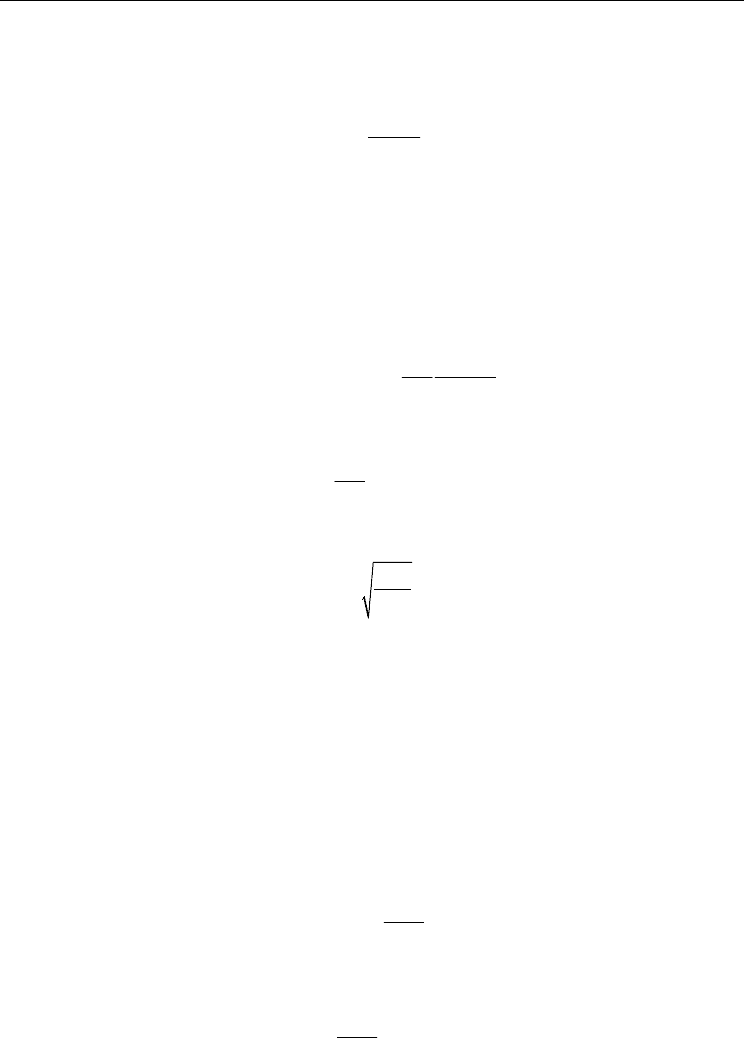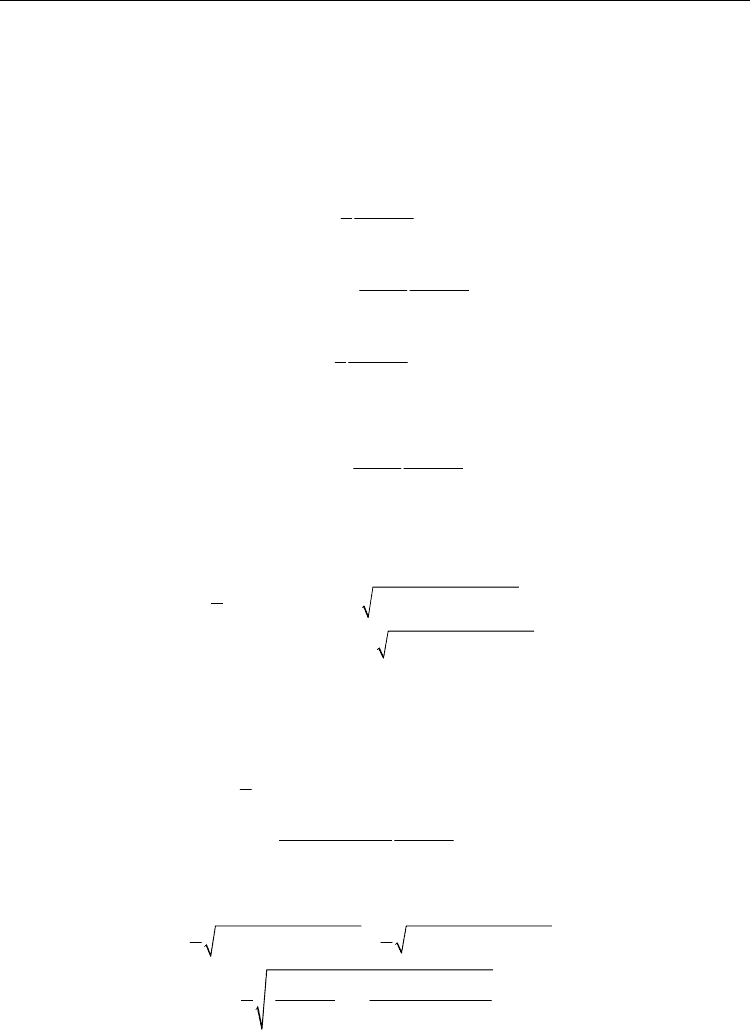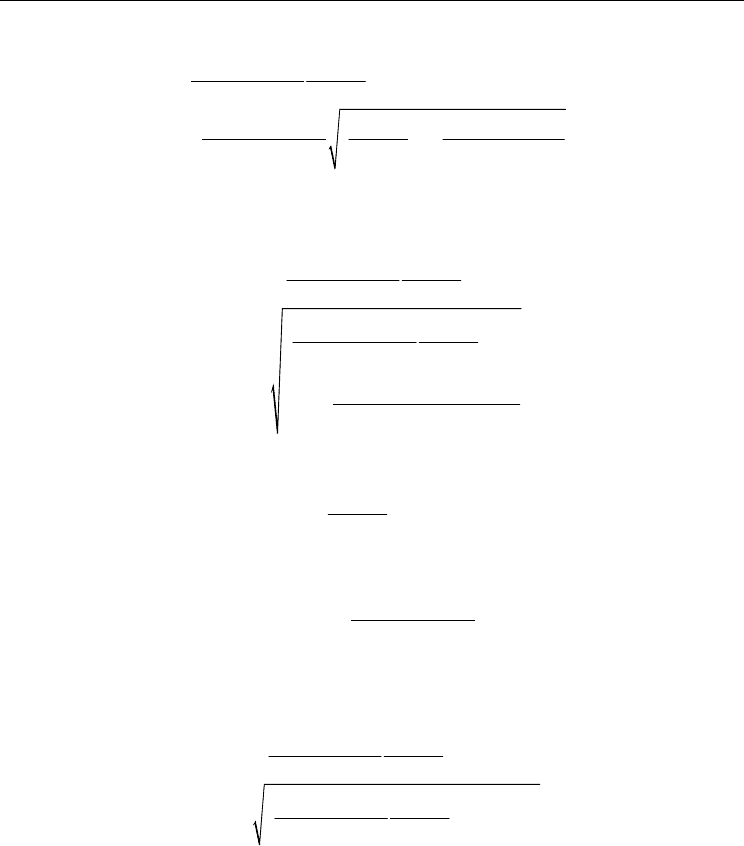Lallart M. Ferroelectrics: Characterization and Modeling
Подождите немного. Документ загружается.


A General Conductivity Expression for
Space-charge-limited Conduction in Ferroelectrics and Other Solid Dielectrics
469
> 0 be both independent of the position x from the electrode where the electric current
flows into the dielectric sample. The flow direction of the electric current is then given by
the positive direction of x. According to Gauss' law, the free-charge density is given by
()
() 0
p
p
dE x
x
dx
(2)
where E
p
(x) is the electric field along the positive direction of x. At steady states, the
continuity equation
0
p
J
(3)
implies that the current density J
p
is independent of the position x. At the absence of both
intrinsic (Ohmic) conductivity and diffusion currents, this current density is given by
2
()
() ()
2
pp
ppp p
dE x
JxEx
dx
(4)
A spatial integration of Eq. (4) from 0 to x using the boundary condition E
p
(0) = 0 yields
2
() 0
2
p
pp
JEx
x
(5)
or equivalently
2
() 0
p
p
p
Jx
Ex
(6)
The present justification for the boundary condition E
p
(0) = 0 is that, at the boundary x =
0, any electric field along the positive direction of x, if it ever exists, would be
`neutralized' by an electric field in the opposite direction as generated by the injected p-
type free carriers (Coelho, 1979). Here we provide a “quantitative explanation” for this: At
x = 0, the electric field satisfies the inequality E
p
(0) ≥ 0. But since, at this boundary, there is
a step change of the free-charge density from zero to some finite positive value, the
inequality E
p
(0) ≤ 0 is also satisfied as any finite local electric field is also expected to be
pointing along the negative direction of x. The simultaneous inequalities E
p
(0) ≥ 0 and
E
p
(0) ≤ 0 together imply E
p
(0) = 0. Using Kirchoff's loop law (i.e. Kirchoff's voltage law)
and Eq. (6), we obtain
1/2
3/2
0
8
()
9
L
p
p
p
J
VExdx L
(7)
Hence,
22
3
9
~
8
p
p
JVV
L
(8)

Ferroelectrics - Characterization and Modeling
470
If n-type instead of p-type free carriers are injected into the dielectric sample, Eqs. (2) and (4)
should be replaced by
()
() 0
n
n
dE x
x
dx
(9)
and
2
()
() ()
2
nn
nnnn
dE x
JxEx
dx
(10)
respectively, where μ
n
> 0, and the subscript n denotes the case of SCLC by only n-type free
carriers. Following a derivation similar to that for the case of p-type SCLC but with a
consideration of the boundary condition E
n
(L) = 0, we obtain
22
3
9
~
8
n
n
JVV
L
(11)
It follows that the scaling relation J ~ V² holds regardless of whether the injected free carriers
are p-type or n-type.
3. Polarization offsets in graded ferroelectrics and the need for a general
local conductivity expression
Our theoretical investigation of SCLC began with a study of the well-known phenomenon of
polarization offsets in compositionally graded ferroelectric films (Bao et al. 2000a, 2000b,
2000c, 2001a, 2001b; Bouregba et al., 2003; Brazier et al., 1998; Chen et al., 1999; Mantese et
al., 1997; Matsuzaki & Funakubo, 1999; Schubring et al., 1992). Ferroelectric materials are
materials that generally exhibit nonlinear, hysteretic D-E or P-E relations, where D is the
electric displacement, P is the polarization and E is the electric field. In contrast to the
“normal” hysteresis loops, i.e. loops that are centred at the origin of the D-E or P-E plot, as
observed for homogeneous ferroelectric films, it was first reported in Physical Review Letters
(Schubring et al., 1992) that compositionally graded ferroelectric films can exhibit vertical
displacements of their hysteresis loops along the polarization axis, i.e. polarization offsets,
when driven by an alternating applied electric field and placed inside a Sawyer-Tower
circuit (Chan et al., 2004; Sawyer & Tower, 1930) for typical D-E measurements of
ferroelectric materials. This intriguing phenomenon, believed to have potential device
applications in infrared detection, actuation and energy storage (Mantese & Alpay, 2005),
has triggered much subsequent research in the ferroelectrics community into a theoretical
understanding of its origin (Alpay et al., 2003; Bouregba et al., 2003; Brazier et al., 1999;
Chan et al., 2004; Fellberg et al., 2001; Mantese & Alpay, 2005; Mantese et al., 1997; Okatan et
al., 2010; Poullain et al., 2002).
Such a phenomenon of polarization offsets in compositionally graded ferroelectric films is
characterized by three key experimental observations: (i) The shift magnitude exhibits a
strong dependence on electric field and temperature (Schubring et al., 1992). In particular, it
typically exhibits a power 3 to 5 dependence on the magnitude of the applied electric field
(Bao et al., 2000a, 2000b, 2000c, 2001b; Bouregba et al., 2003; Brazier et al., 1998; Mantese et
al., 1997); (ii) The vertical hysteresis shift changes from upward to downward, or vice versa,

A General Conductivity Expression for
Space-charge-limited Conduction in Ferroelectrics and Other Solid Dielectrics
471
when the compositional gradient is inverted (Bouregba et al., 2003; Brazier et al., 1998;
Mantese et al., 1997). (iii) A vertical polarization offset typically develops like the charging
up of a capacitor, where the “time constant“ is of the order of magnitude as the product of
the capacitance and input impedance of the reference capacitor in the Sawyer-Tower circuit.
In the past two decades, various theoretical ideas and models have been proposed to
account for the origin of this phenomenon: Originally, the vertical hysteresis shift, or
“polarization offset”, was thought of as a static polarization developed across the graded
ferroelectric film (Mantese et al., 1997), upon excitation by an alternating applied electric
field. However, the experimental values of those “offsets” are at least an order of magnitude
larger than the typical spontaneous polarization of the ferroelectric material, and therefore
such a large static polarization component is deemed unlikely, if not impossible (Brazier et
al., 1999). Other theoretical considerations include an interpretation of the vertical hysteresis
shift as the result of a static voltage developed across the ferroelectric film (Brazier et al.,
1999), as a result of asymmetric electrical conduction by leakage currents in the film
(Bouregba et al., 2003), and as an effect of space charge in a perfectly insulating ferroelectric
film (Okatan et al., 2010).
In our theoretical investigation where all of the key experimental observations mentioned
above were reproduced theoretically (Chan et al., 2004), we proposed that the observation of
polarization offsets in a compositionally graded ferroelectric film is a result of “time-
dependent“ space-charge-limited conduction inside the graded film, where the term “time-
dependent“ was used because the ferroelectric film was excited by an alternating applied
electric field, in contrast to the abovementioned case of steady-state SCLC, in the absence of
displacement currents, as described by the Mott-Gurney law. This central assumption was
based on the following considerations: A similar phenomenon of polarization offsets was
observed for homogeneous ferroelectric films in the presence of a temperature gradient
(Fellberg et al., 2001), where the vertical hysteresis shift disappeared when the applied
temperature gradient was removed. This suggests that, for this particular case,
the shift is a
result of thermally induced gradients in the polarization P (Alpay et al., 2003; Fellberg et al.,
2001), or more generally in the electric displacement D, where the latter implies the presence
of free space-charge according to Gauss’ law. If the vertical hysteresis shifts that arise from
compositional and thermal gradients are of the same origin, the observation of polarization
offsets in compositionally graded ferroelectric films might be mainly a result of electrical
conduction by free space-charge, i.e. SCLC. Here, we have deliberately aborted the
assumption of a perfectly insulating ferroelectric film, as adopted by some other schools of
thought (Alpay et al., 2003; Mantese & Alpay, 2005; Okatan et al., 2010), because
experimental observations of small but finite leakage currents, as well as of SCLC currents,
have been widely reported in the literature for ferroelectrics and other solid dielectrics
(Bouregba et al., 2003; Carbone et al., 2005; Coelho, 1979; Laha & Krupanidhi, 2002; Pope &
Swemberg, 1998; Poullain et al., 2002; Suh et al., 2000) and they form a subject of their own
(Pope & Swemberg, 1998).
For our consideration of SCLC in compositionally graded ferroelectric films, the Mott-
Gurney law J ~ V
2
does not apply, due to the following reasons: (i) In the case of a time-
varying applied voltage, there is also the presence of displacement currents so that the
conduction current J , which now does not necessarily equal the total current, could be
varying with position, i.e. Eq. (3) no longer holds. (ii) In many ferroelectric and dielectric
materials, there exist two opposite types of free charge-carriers, p-type and n-type, with

Ferroelectrics - Characterization and Modeling
472
the system behaving like a wide bandgap semiconductor. Such double-carrier cases are
not considered by the Mott-Gurney law. (iii) The Mott-Gurney law offers no way to take
into account any small but finite intrinsic conductivity of a ferroelectric or dielectric
material. (iv) For non-linear dielectric materials, the dielectric permittivity ε is not a
constant, usually field-dependent, and for ferroelectrics it is even time- or history-
dependent. And for inhomogeneous materials, e.g. compositionally graded ferroelectrics,
ε typically exhibits a spatial variation. In view of these limitations, we have derived a new
local conductivity expression (Chan et al., 2004) that is applicable to cases with the
presence of both p-type and n-type free carriers, with a small but finite local conductivity,
and with any possible dependence of the local dielectric permittivity ε on the system
parameters. It is worth pointing out that a corresponding global conductivity expression,
e.g. the Mott-Gurney law, must be obtained via the continuity condition in Eq. (3) and can
only be derived with knowledge of the relation of ε with other system parameters. For
example, in the derivation of the Mott-Gurney law, ε is a known quantity – it is taken as a
constant, independent of any system parameter. In the following Section, we will review
our original derivation (Chan et al., 2004) of this local conductivity expression, where the
law of mass action was employed as an ad hoc approximation to describe the interactions
between the two opposite types of free charge-carriers. A detailed justification of this
mass-action approximation is provided in subsequent Sections.
4. Original derivation of the general local conductivity expression
For a time-varying applied voltage V(t), the local conduction-current density J
c
(x,t), the local
electric field E(x,t) as well as the local electric displacement D(x,t) are generally functions of
the position x and the time t. The local conduction-current density is related to the local
electric field via a generally time-dependent local conductivity σ(x,t):
(,) (,)(,)
c
Jxt xtExt
(12)
Consider the simultaneous
presence of p-type and n-type free charge-carriers with the
position-dependent mobilities µ
p
(x) and - µ
n
(x), and of electric charges q and –q, respectively.
Here we have chosen µ
p
(x), µ
n
(x) and q to all be positive quantities. Due to charge neutrality,
the intrinsic number concentrations of the two opposite types of free carriers are equal, and
they are here both denoted by the symbol C
in
(x). The time-dependent conductivity can then
be expressed as
(,) ()[ () (,)]
[ ][ ( )][ ( ) ( , )]
pin
nin
xt
q
xC x
p
xt
q
xCx nxt
(13)
where Δp(x,t) and Δn(x,t) are respectively the differences between the intrinsic and total
number concentrations for each type of free carriers. Here we define a generally position-
dependent local intrinsic conductivity
() [ () ()] ()
in p n in
x
q
xxCx
(14)
such that the time-dependent conductivity in Eq. (13) can be expressed as
(,) () [ () (,) () (,)]
in p n
xt x
q
x
p
xt x nxt
(15)

A General Conductivity Expression for
Space-charge-limited Conduction in Ferroelectrics and Other Solid Dielectrics
473
According to Gauss’ law, the density of free space-charge is given by
(,)
[ ( ) ( , )] [ ][ ( ) ( , )]
[(,) (,)]
in in
Dxt
qCxpxt qCxnxt
x
qpxt nxt
(16)
Since there generally exist interactions, i.e. generation and recombination, between the two
opposite types of free charge-carriers, the free-carrier concentrations C
in
(x)+Δp(x,t) and
C
in
(x)+Δn(x,t) are not independent of each other, and should be described by an additional
physical constraint
[(,),(,)]0Fpxt nxt
(17)
As an ah hoc approximation, we regard any ferroelectric or dielectric material as a wide
bandgap semiconductor and then employ the equilibrium law of mass action to be this
additional physical constraint:
2
() [ () (,)][ () (,)]
in in in
Cx Cx
p
xt C x nxt
(18)
The physics described by Eq. (18) is as follows (Chan et al., 2007): In a wide bandgap
semiconductor, there are the endothermic generation and exothermic recombination of
free charge-carriers. If the energy released by free-carrier recombination is immediately
used for free-carrier generation, i.e. a “heat balance“ condition, the rates of these
endothermic and exothermic processes must be equal, and there would not be any net
production of heat nor any net generation of free carriers. On the other hand, the rate of
each of these processes can be assumed, as a first approximation, to be proportional to the
product of the reactants’ concentrations, i.e. the number of ways per unit volume the different
types of reactants can combine to undergo the process. Since, for a dielectric insulator, the
concentration of the source particles for free-carrier generation (e.g. valence electrons or
molecules) is by definition orders of magnitude larger than the concentrations of the free
carriers, the concentration of source particles, and hence the rate of free-carrier
generation, should only have an insignificant time fluctuation and should practically be a
material-pertaining property. It follows that any rate of free-carrier recombination, which
we have here assumed to be proportional to the product of the concentrations of p-type
and n-type free carriers, can all be taken as equal to the same approximately time-
invariant
rate of free-carrier generation, hence Eq. (18).
Upon rewriting Eqs. (16) and (18) as
1(,)
(,) (,)
Dxt
p
xt nxt
qx
(19)
and
()[ (,) (,)] (,) (,) 0
in
C x pxt nxt pxt nxt
(20)
respectively, it can be seen that two quadratic equations, for Δp(x,t) and Δn(x,t) respectively,
can be obtained:

Ferroelectrics - Characterization and Modeling
474
2
(,) (,) (,) (,) 0
pp
pxt B xt pxt C xt
(21)
and
2
(,) (,) ( ,) ( ,) 0
nn
nxt B xt nxt C xt
(22)
where
1(,)
(,) 2 ()
pin
Dxt
Bxt C x
qx
(23)
()
(,)
(,)
in
p
Cx
Dxt
Cxt
q
x
(24)
1(,)
(,) 2 ()
nin
Dxt
Bxt C x
qx
(25)
and
()
(,)
(,)
in
n
Cx
Dxt
Cxt
q
x
(26)
It follows that
2
2
[()(,) ()(,)]
{ ()[ (,) (,) 4 (,)]
2
()[ (,) (,) 4 (,)]}
pn
pp p p
nn n n
qxpxt xnxt
q
x B xt B xt C xt
x B xt B xt C xt
(27)
Using the definitions of the quadratic coefficients B
p
(x,t), C
p
(x,t), B
n
(x,t) and
C
n
(x,t), as well as the definition of σ
in
(x) in Eq. (14), the following relations can be
obtained:
[()(,) ()(,)]
2
[() ()]
(,)
()
2
pp nn
pn
in
q
xB xt xB xt
xx
Dxt
x
x
(28)
and
22
2
2
2
(,) 4 (,) (,) 4 (,)
22
4()
1(,)
2
[() ()]
pp nn
in
pn
qq
BxtCxt BxtCxt
x
Dxt
x
xx
(29)
Using Eqs. (15), (28) and (29), Eq. (27) can be rewritten as

A General Conductivity Expression for
Space-charge-limited Conduction in Ferroelectrics and Other Solid Dielectrics
475
2
2
2
[()(,) ()(,)]
[() ()]
(,)
()
2
[() ()]
4()
(,)
2
[() ()]
(,) ()
pn
pn
in
pn
in
pn
in
qxpxt xnxt
xx
Dxt
x
x
xx
x
Dxt
x
xx
xt x
(30)
so that an expression for the time-dependent local conductivity σ(x,t) can be obtained:
2
22
2
[() ()]
(,)
(,)
2
[() ()]
(,)
2
[() ()]()
[() ()]
pn
pn
pnin
pn
xx
Dxt
xt
x
xx
Dxt
x
xxx
xx
(31)
According to Eqs. (15), (16) and (31), for the case of Δp(x,t) = Δn(x,t) = 0, we have
(,)
0
Dxt
x
(32)
and
[() ()]
(,) () ()
[() ()]
pn
in in
pn
xx
xt x x
xx
(33)
where the latter implies that only the root of all upper positive signs in Eq. (31) is valid.
Therefore, the correct expression for the time-dependent conductivity should be:
2
2
[() ()]
(,)
(,)
2
[() ()]
(,)
()
2
pn
pn
in
xx
Dxt
xt
x
xx
Dxt
x
x
(34)
which describes a nonlinear relation between the space-charge density and the overall local
conductivity in the presence of a non-zero intrinsic conductivity.
5. Limiting case of zero intrinsic conductivity
Consider a case where σ
in
(x) 0 but σ(x,t) remains finite. According to Eq. (15), either µ
p
(x)
or µ
n
(x) has to be non-zero for σ(x,t) to remain finite. From the definition of the intrinsic
conductivity in Eq. (14), for σ
in
(x) 0 we must have C
in
(x) 0, because the mobility sum
[µ
p
(x) + µ
n
(x)] is finite. For C
in
(x) 0, Eq. (20) becomes

Ferroelectrics - Characterization and Modeling
476
(,) (,) 0pxt nxt
(35)
Multiplying both sides of Eq. (19) by Δp(x,t) or Δn(x,t) and then applying Eq. (35), we obtain
1(,)
(,) (,) 0
Dxt
pxt pxt
qx
(36)
and
1(,)
(,) (,) 0
Dxt
nxt nxt
qx
(37)
The solutions to Eqs. (36) and (37) are
1(,)
(,) 0, (,)
Dxt
pxt pxt
qx
(38)
and
1(,)
(,) 0, (,)
Dxt
nxt nxt
qx
(39)
respectively. According to Eq. (19), however, only the following combinations of solutions
are allowed.
1(,)
(,) 0 (,)
Dxt
pxt and nxt
qx
(40)
and
1(,)
(,) 0 (,)
Dxt
nxt and pxt
qx
(41)
Since C
in
(x)
0, the quantities Δp(x,t) and Δn(x,t) effectively become the total free-carrier
concentrations and must therefore be non-negative. Eqs. (40) and (41) thus lead to an
important conclusion: At the limit of zero intrinsic conductivity, either p-type or n-type free
charge-carriers become dominant, with the cases of
(,)
0
Dxt
x
(42)
and
(,)
0
Dxt
x
(43)
corresponding to the dominance of p-type and n-type free charge-carriers, respectively. This
conclusion provides a linkage between two of the three independent assumptions, i.e. the
absence of an intrinsic conductivity and the presence of only a single type of free charge-

A General Conductivity Expression for
Space-charge-limited Conduction in Ferroelectrics and Other Solid Dielectrics
477
carriers, in the original derivation of the Mott-Gurney law: Although Eqs. (40) and (41) only
conclude that the simultaneous presence of p-type and n-type free carriers is locally
forbidden, this conclusion also holds globally across a dielectric sample for the case of a
plane-parallel dielectric capacitor as described by the Mott-Gurney law. In the absence of
diffusion currents, the total-current density J is equal to the conduction-current density J
c
,
and they are both spatially continuous; For any non-zero total-current density J, the space-
charge density must be non-zero everywhere, otherwise there would be the case of J = J
c
= 0
somewhere in the sample. Globally, regions of positive space-charge density and regions of
negative space-charge density cannot be present simultaneously in the dielectric sample,
otherwise there would exist inter-regional boundaries of zero space-charge density at which
J = J
c
= 0. It follows that the space-charge density must be of the same sign across the
dielectric sample as well, which implies that the simultaneous presence of p-type and n-type
free charge-carriers is also globally forbidden.
For σ
in
(x) 0, Eq. (34) becomes
[() ()]
(,)
(,)
2
[() ()]
(,)
2
pn
pn
xx
Dxt
xt
x
xx
Dxt
x
(44)
If Eq. (42) holds, we have
[() ()]
(,)
(,)
2
[() ()]
(,)
2
(,)
()
pn
pn
p
xx
Dxt
xt
x
xx
Dxt
x
Dxt
x
x
(45)
Else if Eq. (43) holds, we have
[() ()]
(,)
(,)
2
[() ()]
(,)
2
(,)
()
pn
pn
n
xx
Dxt
xt
x
xx
Dxt
x
Dxt
x
x
(46)
Eqs. (45) and (46) together verify that, in the case of σ
in
(x) 0, the charge mobility in the
expression for the generally time-dependent local conductivity σ(x,t) is correctly equal to
that of the dominant type of free carriers.
6. Derivation of a general expression for the local diffusion-current density
Apart from electrical conduction, i.e. the electric-field-driven flow of free charge-carriers,
there also exists the possibility of charge diffusion due to the presence of a charge-density

Ferroelectrics - Characterization and Modeling
478
gradient or a temperature gradient, where the latter is often being referred to as the
thermoelectric effect. For any bulk dielectric sample, consider the i
th
infinitesimal volume
with dimensions ∆x, ∆y and ∆z. Along the x-direction, for example, the net force acting on
the p-type free carriers within this infinitesimal volume is given by
,,1,1
()
pi pi pi
FP P
y
z
(47)
where P and the subscript p denote the local pressure and p-type free charge-carriers,
respectively. The total amount of charge carried by the p-type free carriers in this
infinitesimal volume is
,pi p
Q
q
Cx
y
z
(48)
where
pin
CC
p
(49)
is the total concentration of p-type free carriers for this infinitesimal volume. The
corresponding force per unit charge, i.e. the mechanical counterpart of the electric field, is
then given by
,,1,1
,
,
()
pi pi pi
pi
pi p
FPP
E
QqCx
(50)
And for the case of conduction by n-type free carriers, we have
,,1,1
,
,
()
()
ni ni ni
ni
ni n
FPP
E
QqCx
(51)
where
nin
CC n
(52)
is the total concentration of n-type free carriers. In the continuum limit, Eqs. (50) and (51)
can be replaced by
(,)
1
(,)
(,)
p
p
p
Pxt
Ext
q
Cxt x
(53)
and
(,)
1
(,)
[(,)]
n
n
n
Pxt
Ext
qC x t x
(54)
respectively. The diffusion-current density is then given by
(,) [ () (,) (,)
() (,) (,)]
(,)
(,)
() [ ()]
dppp
nn n
p
n
pn
Jxt q xCxtExt
xC xtE xt
Pxt
Pxt
xx
xx
(55)
